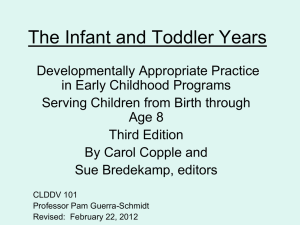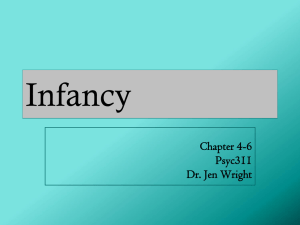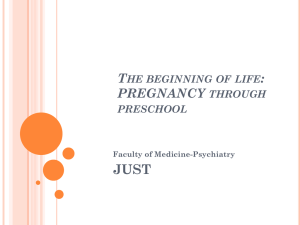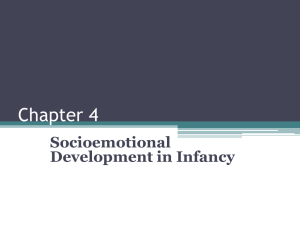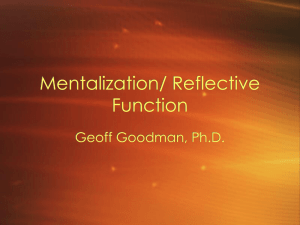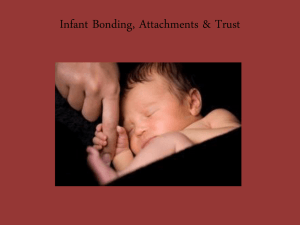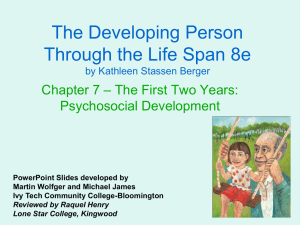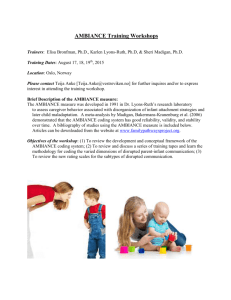Brain and Emotional Development
advertisement
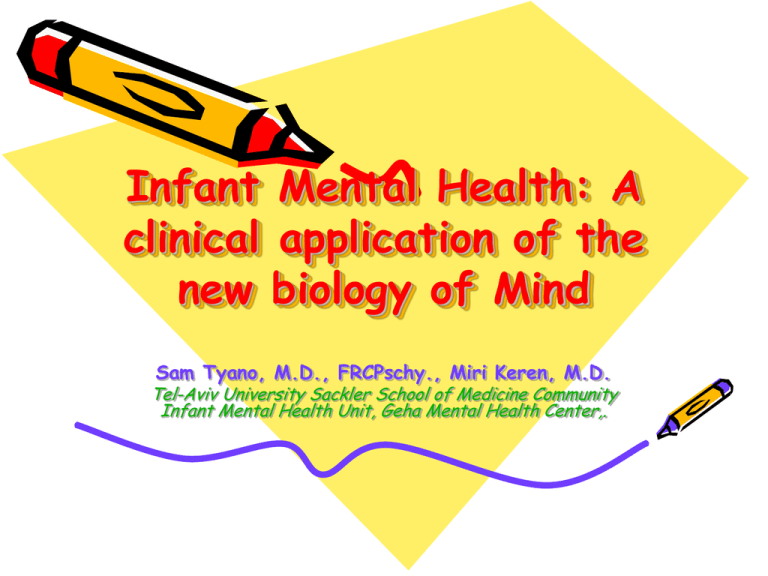
Infant Mental Health: A clinical application of the new biology of Mind Sam Tyano, M.D., FRCPschy., Miri Keren, M.D. Tel-Aviv University Sackler School of Medicine Community Infant Mental Health Unit, Geha Mental Health Center,. What was known until Kandel • The human brain growth spurt begins in the last trimester of pregnancy, is at least five-sixths postnatal, and continues to about 18-24 months of age (Dobbing & Sands, 1973). • DNA production in the cortex increases dramatically over the course of the first year. “A new intellectual framework for psychiatry” Kandel, 1998, Am J Psychiat, 155, 457-469 Genetically encoded information + Neural activation by experience = Activation of genes --- creation of proteins needed for shaping brain structure. • Learning leads to changes in synaptic strength at specific synapses, and memory is associated with the persistence of those changes (Kandel). • Interactive experiences directly impact genetic systems that program brain growth (Schore, 1994, 2001) The current Model (Cicchetti & Tucker, 1994) • The traditional assumption was that the environment determines only the psychological components of development, such as memory and habits, while brain anatomy matures on its fixed ontogenetic calendar. • Environmental experience is now recognized to be critical to the differentiation of brain tissue itself. From brain to mind • During the early years of life, the basic circuits of the brain are developing which will be primarily responsible for a number of important mental processes, involving emotion, memory, behavior and interpersonal relationships. Where, in the brain? • Early interpersonal affective experiences have a critical effect on the early organization of the limbic system (Cingulate, septum, orbito-frontal cortex, hypothalamus, amygdala, hippocampus), an area of emotion processing, organization of new learning, and capacity to adapt to a rapidly changing environment (Mesulam, 1998). About the limbic system… (Blonder et al, 1991; Wexler et al, 1992; Spence et al, 1996) • It is expanded in the non-verbal right hemisphere. • It is centrally involved in the processing of the physiological and the cognitive components of emotions without conscious awareness. • It is centrally involved with emotional communication. Right versus Left hemisphere functions during Infancy • While the left hemisphere mediates most of the linguistic behaviors, the right hemisphere is important for broader aspects of communication. • The right hemisphere is precisely the one that is dominant during the first 3 years of life (Chiron et al, 1997). The cyclic growth of the brain hemispheres (Thacher, 1994) • Hemispheric brain growth is cyclic and continues asymmetrically throughout childhood: – First year: Right hem. spurts – 1.5- 2.5 yrs: Left hem. spurts – 2.5- 4.5 yrs: Right – 4.5- 6 years: Left – 6.5- 10.5 yrs: Right Still, in the first 3 yrs, the right hemisphere is dominant : resting cerebral blood flow shows a right hemisphere dominance, which then shifts to the left on the 4th year (Chiron et al, 1997) Brain MRI supports the idea of “the crucial first 3 years” • The volume right than left of the brain increases rapidly during the first 2 years, and normal adult appearance is seen at 2 yrs. • Infants under 2 yrs show higher hemispheric volumes. • All major fiber tracts can be identified at age 3. (Matsuzawa et al, 2001) “Left brain, Right mind” • These findings about the right brain links with emotional communication and unconscious affective processing led to the notion of “right mind” (Ornstein, 1997) and has become the scientific ground for the new field ”neuropsychoanalysis” MRI and the Social Smile • Functional brain MRI of 8 weeks-old infants showed the biological correlate of the social smile seen in face-to-face interactions: a rapid metabolic change occurs in the primary visual cortex of the infants, reflecting the onset of a critical period in which synaptic connections in the occipital cortex are modified by visual experience. (Yamada et al, 2000) . Attachment experiences and the interactive regulation of the right brain • The right brain is dominant in human infants (Chiron & al, Brain, 1997). • Attachment experiences, also dominant in infancy, specifically impact the development of the infant’s right brain limbic system (Schore, 1994; Ryan et al, 1997, Keenan et al, 2001). Attachment experiences: Definition • From 3 months on, the infant internalizes “schemas-of-being-with- different caregivers and around various situations (D. Stern, 1985, The Interpersonal World of the Infant). • The attachment experience occurs around daily stress situations: the securely attached infant to a specific caregiver has developed a schema of “This-personmakes-me feel-safe-and-protected-whenI-am-in-distress”. Secure Attachment facilitates secure Exploratory behavior I need you to… Support my exploration •Watch over me •Help me •Enjoy with me I need you to… •Comfort me •Delight me •Protect me •Organize my feelings Welcome my coming to you The concept of Resonance • The attuned dyad infant-parent constitutes a biologically-based “conversation between limbic systems”, where the behavioral manifestation of each partner’s internal state is monitored by the other. • Therefore affect regulation is not only the dampening of negative emotions, but also the amplification of positive emotions. A context of resonance • The infant’s right hemisphere is involved in attachment behaviors. • The mother’s right hemisphere is involved in comforting functions. (Siegel, 1999) Resonance and intergenerational transmission • Empirical finding (Hesse, 1999): 75% concordance between the infant’s pattern of attachment to the parent’s attachment classification (i.e. autobiographical narrative coherence, as measured by the AAI). • The concept of resonance may explain this finding at the neural level : the parent’s internal integration of emotional experiences promotes the infant’s interpersonal experience integration. Experiences, memory, and brain development • Without memory, there is no development: memory is the way in which past experience is encoded in the brain and shapes present and future functioning. • Kandel: Long-term memory differs from short term memory in requiring the activation of a cascade of genes, this genetic program leads to the growth of new synaptic connections. Developmental path of memory • First year of life: Implicit memory only (unconscious, no sensation of recall, but influence on behaviors and emotions directly, in the here and now). • By 1.5 yr, explicit memory starts, and by 3yrs is established: conscious retrieval, with the internal sensation of “I am recalling something now”. Maturation of the hippocampus in the medial temporal lobe is necessary for it. To summarize (1) • The mental apparatus becomes a regulatory system as a product of the experience-dependent maturation of the orbitofrontal system (Bechara, Damasio et al, 1997). • Such non-conscious regulatory mechanisms are embedded in implicit-procedural memory of internal working models of the attachment relationship that encode strategies of affect regulation. The right hemisphere is dominant for implicit learning (also for “intuititive parenting”?). To summarize (2) • The expanding ability of the growing individual to cope with interpersonal and bodily stressors is an important achievement in continuing human development, and reflects the growth of the right brain, the hemisphere dominant for the human stress response. • In terms of interpersonal stressors, the right hemisphere is specialized for processing facially expressed auditory and visual emotional information, from infancy into adulthood. Infancy and Neural plasticity are therefore good friends… Experiences shape the brain by: – Strengthening, weakening or pruning synapses formed from primarily genetically encoded information. – Formation of new synapses. – Increasing linkages among neurons by repeated experience (memory). – Laying down myelin and thus increasing the speed of conduction. – Elimination of synapses by toxic substances and stressful or absent experiences. Major significance Interventions targeted to improve/change early childhood experiences = Intervention at the level of brain development This is the scientific rationale for Infant Psychiatry… • We detect high risk infants and/or parents for early relationship disturbances. • We treat the parent-infant relationship (dyadic/triadic parent-infant psychotherapies). • This new relational experience is believed to impact on the infant’s brain development, and optimize the quality of the object relationships he/she will develop along the years, and on the parental reflective functioning. PREVENTION EARLY DETECTION EARLY TREATMENT in creating or restoring favorable conditions for the young child’s development and mental health. Targets of prevention Prevention in Infant Mental Health focuses mainly on changing the human and physical environment of the infant (which he totally depends on), in order to improve the way the child experiences himself in the external world. Selective prevention • Target Population: Infants, asymptomatic, exposed to biological or environmental risk factors that has been detected (based on pre-existing empirical research studies) and/or Parents at Selecting target of intervention Identification of risk factors in: • Environment (violence, poverty, unemployment, family structure). • Parent (education status, mental distress, lack of parental skills). • Child (biological vulnerability, rough temper). • Parent-Child (lack of kindness, lack of pleasure, conflict). Impact of studied selective prevention programs (1). • van den Boom, 1994: Target: Difficult infant temperament + low SES mothers Aim: To increase maternal sensitivity Action: attachment-focused guidance during period of attachment (age 6-9 mos). 3 years-long effect: 68% secure attachment vs 28% in non-intervention matched group. Impact of studied selective prevention programs (2). • Webster-Stratton (1990): Target: Coercive-criticizing-harsh parents Aim: To decrease chance of later conduct disorder. Action: Videotapes reviewing and reflecting with parents. Effect: Decreased incidence of behavioral pbs . Limitation: Short followup. Impact of studied selective prevention programs (3). • McCarton (1997): Target: 12 months-old VLBW premature babies and parents Aim: Decrease risk for later cognitive, developmental and behavioral problems Action: Special parent-child day care for 2 years. Effect: Higher IQ and less behavior pbs at 3 yrs of age, versus control group. Impact of studied selective prevention programs (4). • Lyons-Ruth et al (1990): Target: Depressed and low-parental skilled mothers. Aim: Enhance security of attachment and functioning in infants. Action: Home visits every week during first 13 months. Effect: More secure and better functioning of the infants at 18 months versus control. Impact of studied selective prevention programs (5). • Olds’s (1997) longest longitudinal study: From pregnancy to adolescence (15yrs): Target: 400 multi-environmental risk pregnant mothers. Aim: Decrease risk for delinquency & abuse. Action: Home-guidance by nurses. Effect: Less delinquency, less abuse and less subsequent births. Conclusions Focused interventions in high risk populations seem efficient, at least on a short-term basis. A worrying stability of developmental/ emotional/ social symptoms, exists from infancy up to school-age. ARRANGEMENT - FOSTER CARE MEDICAL AND PARAMEDICAL TREATMENTS INTERACTION GUIDANCE PSYCHOTHERAPIES : dyadic – triadic – family - group Psychoanalytically oriented – Cognitive/behavioral – SET-PC PHARMACOTHERAPY Intervention during Infancy: its levels of impact • Behavioral level: Role modeling • Affective level: Therapist as Secure Base • Psychological level: - To identify parental projections on infant and to connect them with past exp. - To enhance the “Parental Reflective Functioning”. “The parent-infant relationship is the patient” (D. Stern) Role of Baby’s presence in the therapy session -As a trigger of unconscious affects and projections in real time in parents. - As a listener to therapist’s comments and perceptions of his/her behaviors (Therapist’s Reflective functioning stance) Role of Father’s presence: “Schema-of-being-with-M-&-F” How to intervene • Interactional guidance: “Here and Now” in the interaction. Use of videotape reviewing. • Psychodynamic dyadic/triadic psychotx: Use interactional micro-events to identify conflictual/ pathological parental projections on infant (“Ghosts in the nursery”). • Psychodynamic short-term psychotx: SET-PC

